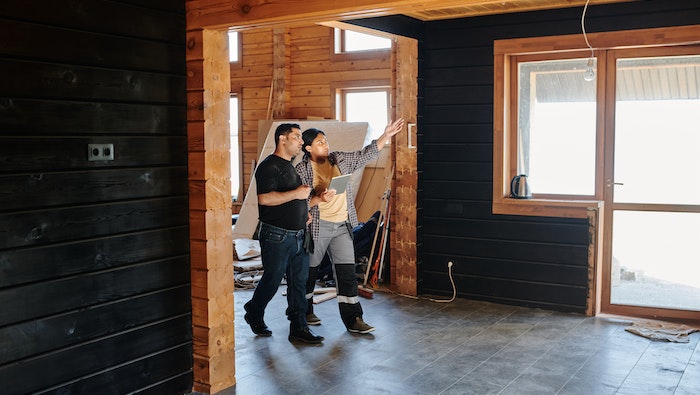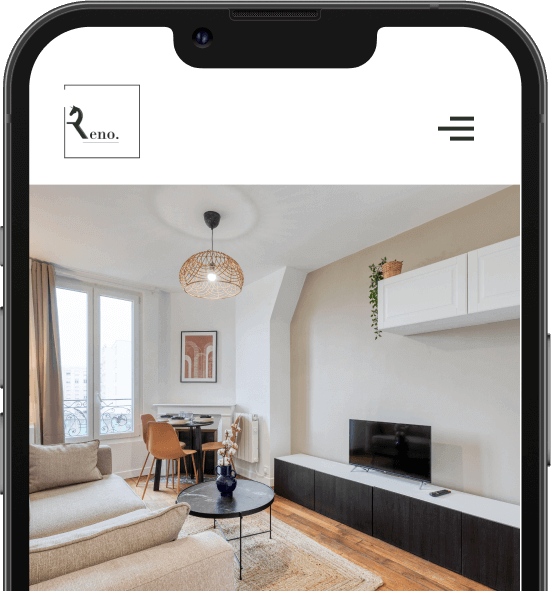Interior architects who also serve as project managers draw upon their passion for their profession, their keen tastes, their skills, and their expertise honed over years of experience to perfectly meet your expectations. Whether in Paris or elsewhere in France, don't hesitate to invest in property (as a rental property or primary residence)! Whether it's a house or an apartment, redesigning your interior adds value, creates a more functional and aesthetic environment. The goal here is to optimize spaces while adding a specific style that aligns with your needs, personality, and taste. To navigate through the various building professions, it's important to understand the role of this space designer. In this article, you'll discover the 5 key points about the tasks of this artisan.

A Profession Rich in Creativity
Want to make changes to the interior of your home? The solution is to choose an interior architect. However, it's important to know who you're dealing with beforehand. This project manager works in the layout or renovation of apartments, houses, offices, shops, museums, and more. Their job is to create functional, aesthetic, and comfortable interior spaces. They do not intervene on the building's structure.
The space designer, also known as an interior architect, works with existing structures and plays with shapes, colors, lines, volumes, materials, and light. They take into account the technical constraints of the property and the client's budget (client or contractor). They create project plans by hand or using CAD (Computer-Aided Design) software or 2D and 3D software. Then, they present sketches and technical and financial study descriptions of the works to the client, while considering aspects related to design, layout, and decoration.
Once the project is approved, the interior architect and the client draft the specifications on which the site will be based, integrating aspects related to Paris, materials, budgets, and spaces. This document outlines the objectives, budgets, and deadlines to be met by the project manager, while considering the specific needs of the clients. Apart from the layout and renovation of offices and shops, this professional can create sets and debate platforms, thus participating in a variety of projects and sectors. They also have the option to work as a freelancer, individually or as a partner in an agency, offering tailor-made layout and design services. Often, they are employed in an architecture studio, collaborating with other architects and designers to realize interior design, renovation, and layout projects tailored to the needs of their clients. The CFAI, or Interior Architects Training Center, plays an essential role by offering specific training for those who wish to enter this exciting profession.
A Well-Founded Collaboration
The interior architect entrusted with your layout or renovation program follows precise steps, during which you will be regularly consulted. With the help of this artisan, you can invest with peace of mind.
1st Step: Preliminary Meeting
In this first step, interior architects meet with their client to gather all the information needed to understand the layout or renovation project. During a preliminary meeting, these architecture professionals:
- – analyze the needs, constraints, tastes, and budget of the client;
- – visit and measure the space to be arranged;
- – define the scope of the mission;
propose initial ideas for layout, materials, furnishings, and equipment.
2nd Step: Study and Project Development
After the preliminary meeting, architecture professionals move on to the 2nd step, namely the study and development of the project.
Sketch Studies (ESQ)
After the initial contact with their client, interior architects conduct sketch studies. To do this, they:
- – analyze the program and budget proposed by the client;
- – study the documents obtained from technical and administrative services;
- – examine the documents and plans of existing buildings;
- – create initial sketches allowing the client to refine their project by providing specifics.
Then, they submit the file to the client for approval.
Preliminary Draft (APS)
After the sketches are approved by the client, architecture professionals verify whether the initial drafts comply with current regulations, then they proceed to:
- – create plans to scale 1/100th based on the approved sketch, and any sketches or diagrams;
- – provide a brief description of the work to be carried out by each trade;
- – establish a provisional estimate of the site to be undertaken;
- – propose a schedule for executing the works.
They then submit the file to the client for validation.
Final Draft (APD)
After approval of the preliminary draft, interior architects move on to the final draft, which includes several phases, namely:
- – technical and architectural diagnosis: ensures that the building and its environment support certain transformations;
- – consultation of public services;
- – creation of plans to scale 1/50th, with all the necessary data for understanding the project;
- – detailed description of the work to be done by trade and their characteristics;
- – final estimation of the cost of the works.
This phase ends with the submission of the file to the client for approval.
3rd Step: Administrative Formalities
The third step concerns the Administrative Authorization File (DAA) and the General Design Pieces (PCG).
Administrative Authorization File
The project manager assists the client in administrative procedures. Specifically, the application for building permits and administrative authorizations. To do this, they create all the graphic elements and assist the client in assembling the administrative file to be sent to the city's urban planning department.
General Design Pieces
After the approval of the final draft and the obtaining of administrative authorizations, the architecture professional gathers all the detailed plans. These are essential for the realization of the project by the consulted artisans. Based on these graphic elements, these trades will be able to define the scope, characteristics, and quality of their services. The general design pieces mention:
- – detailed technical specifications of the program,
- – detailed description by trade,
- – provisional schedule of works,
- – essential graphic elements for consultation.
Subsequently, the interior architect submits the PCG to the client.
4th Step: Consultation File for Companies (DCE)
In this fourth step, the client can choose to competitively tender several companies. With the help of the project manager, they select the method of consulting artisans, the conditions for carrying out the works, and establish the list of companies to be consulted. In this fourth step, the architecture professional is responsible for:
- – creating the consultation file, including administrative clauses and graphic elements;
- – analyzing the economic and technical aspects of the offers;
– designing the selected offer for each trade.
5th Step: Monitoring and Acceptance of Works
Les travaux démarrent après l’obtention de l’accord signé par le commanditaire. L’architecte d’intérieur peut alors passer à la 5e étape, précisément la coordination et le suivi du chantier. Sa mission concerne, par exemple, la transmission des directives auprès des entrepreneurs, l’organisation, et la direction des réunions d’études par rapport au chantier. Il assure également l’Assistance des opérations de réception des travaux (AOR). En cas de malfaçons constatées, le maître d’œuvre détermine si elles doivent impliquer une réfection totale, partielle, ou une déduction pécuniaire.
|
Step |
Description |
|
1st Step: Preliminary Meeting |
– Analyzing the client's needs, constraints, costs, and budget. – Visiting and measuring the space to be designed. – Defining the scope of the mission – Proposing ideas for layout, materials, furnishings, and equipment |
|
2nd Step: Study and Project Development |
– Sketch Studies (ESQ): Analyzing the program and budget, studying documents, creating sketches. – Preliminary Draft (APS): Creating plans to scale, brief description of works, provisional estimate, planning. – Final Draft (APD): Technical diagnosis, consultation of public services, detailed plans, description by trade, final cost estimation. |
|
3rd Step: Administrative Formalities |
– Administrative Authorization File (DAA): Assisting the client in administrative procedures, building permit application. – General Design Pieces (PCG): Gathering detailed plans, technical specifications, detailed description, schedule, graphic elements. |
|
4th Step: Consultation File for Companies (DCE) |
– Creating the consultation file, including administrative clauses and graphic elements. – Reviewing, economic and technical study, comparing offers – Designing the selected offer for each trade |
|
5th Step: Monitoring and Acceptance of Works |
– Coordination and site monitoring, issuing directives to contractors, organizing study meetings. – Assistance in the reception operations of the works (AOR), management of defects and necessary repairs. |
Professional Training for an Expert
Architects and interior architects may sound similar due to their names, but they are actually two distinct professions. These two artisans do not work on the same subject and follow different studies. Professional training in interior architecture involves design, scenography, and decoration fields, notably a combination of plastic, decorative, and graphic arts.
To begin studies in interior architecture, you must hold a high school diploma in STD2A (Sciences and Technologies of Design and Applied Arts). For those with other high school diplomas, professional training is accessible provided they complete a year of Preparatory Course in Applied Arts (MANAA).
To access the profession of interior architect, a bachelor's degree +4 minimum is required. The training paths leading to this position after a Bachelor's degree are:
|
Level of Studies |
Diploma |
|
Bac+2 |
BTS ERA (Advanced Technician's Certificate in Layout and Realization Studies) |
|
Bac+3 |
DN MADE (National Diploma in Art and Design Professions) |
|
Bac+4 |
DSAA (Higher Diploma in Applied Arts, Design Space) |
|
Bac+5 |
DNSEP (National Higher Diploma in Plastic Expression, Design) or diploma from specialized schools in design and interior architecture. |
By collaborating with a qualified interior architect, you can be sure to succeed in your real estate project.
Interior Architect: Salary Depending on Employment

In principle, in the workplace, a completed mission means compensation. For the job of interior architect, the monthly amount depends on their status, especially as an employee of an agency in Paris, where many companies are looking for talent in design, layout, and renovation. Interior architects working on space planning projects, apartment decoration, or kitchen fitting must manage the budget allocated by their clients and choose materials wisely. Whether in a studio or an agency, the ability to develop custom plans and projects is crucial to meet clients' needs.
Interior architects can work with decorators and layout specialists to ensure the success of their work and fully satisfy their clients. Whether planning renovations, designing custom spaces, or optimizing the use of allocated budgets, the profession of interior architect in Paris, for example, offers many opportunities for those who want to combine creativity and technical expertise in space planning.
Salary for an Interior Architect Employed by an Agency
An interior architect who chooses to work for an agency accepts that their salary is regulated by the national collective bargaining agreement for architecture companies. In other words, this agreement sets the maximum amount of income for the project manager. However, the monthly salary varies depending on the mission:
|
Position |
Gross Salary (€) |
Net Salary (€) |
|
Project Assistant |
Between €2,000 and €2,900 |
Between €1,560 and €2,262 |
|
Project Manager |
Between €3,000 and €3,400 |
Between €2,340 and €2,550 |
|
Project Director |
Between €3,900 and €4,800 |
Between €2,925 and €3,600 |
In addition to their salary, the architecture expert receives bonuses, bonuses, and benefits in kind, such as a company car. Note that the amount of the monthly salary varies from one region to another.
Salary for an Independent Interior Architect
The salary of independent interior architects is difficult to evaluate. Different criteria influence their income, such as experience, location, practiced rates, specialization... Moreover, they have the possibility to set their rate as they see fit and according to the calculation method they prefer. Here are examples of billing methods for the job of independent interior architect :
|
Billing Method |
Price Range (€) |
|
Per Hour |
Between €70 and €200 |
|
Per Square Meter |
Between €40 and €70 |
|
As a percentage of the tax-free amount of the works |
Between 8% and 15% |
As an indication, this job allows earning between €2,700 and €4,200 per month. However, in Paris or elsewhere in France, the independent interior architect pays taxes, contributions, and taxes.
Entrust your work to an interior architect!
For the layout or rehabilitation of your house, apartment, or commercial premises, you will need an interior architect. Nevertheless, your choice should not only be based on the location of the craftsman's headquarters (in Paris or in other French cities). Referring to the qualities and skills of the latter is wise. A good interior architect is creative, inventive, has a sense of listening, and carries out their mission with meticulousness and precision. Similarly, they must demonstrate imagination and artistic sensitivity.
Regarding skills, the professional project manager must have a good sense of organization, mastery of drawing and architecture software. Equipped with an extensive knowledge of materials and construction trades, they can carry out their missions according to the rules of the art. Apart from that, skills in art history and solid artistic knowledge should be considered. This is if your real estate investment concerns the renovation of old housing in Paris or in other historical cities in France.
At Reno, we provide you with qualified and competent architects. They will take care of your project from A to Z!





